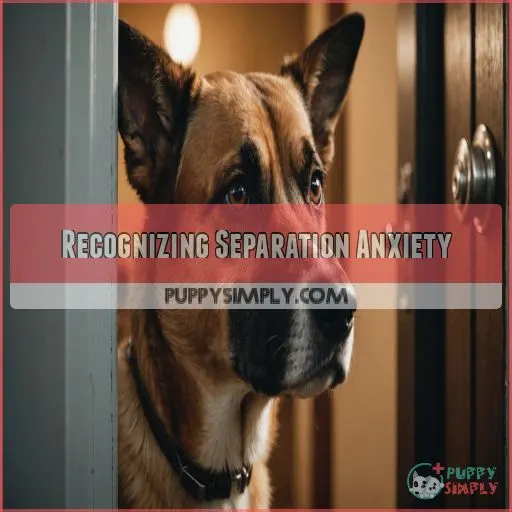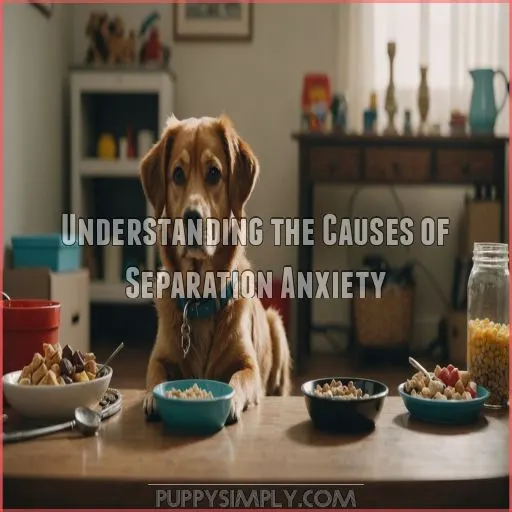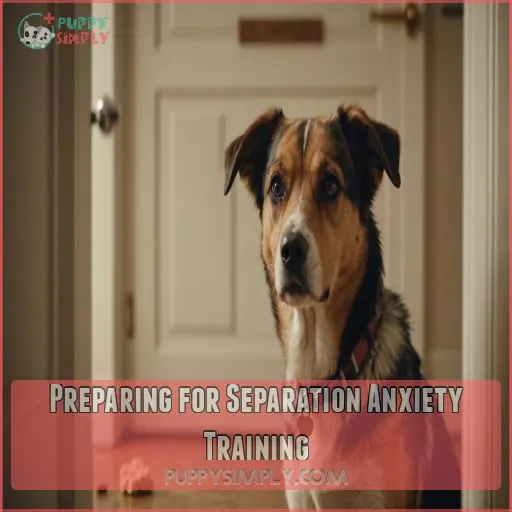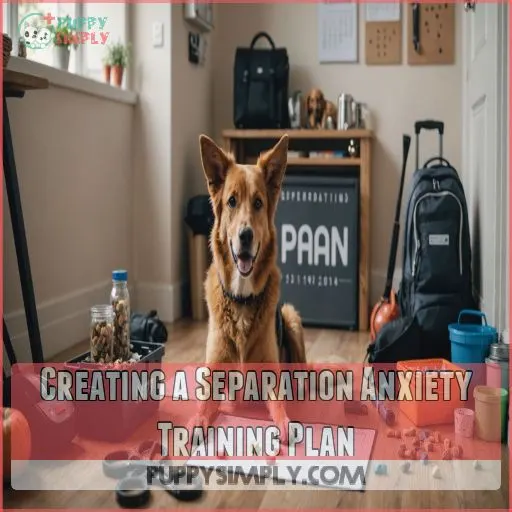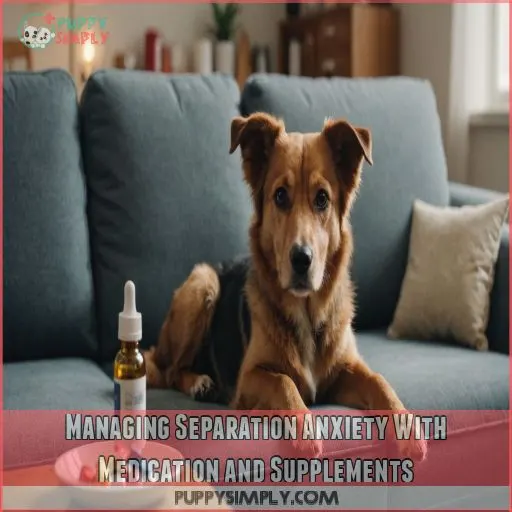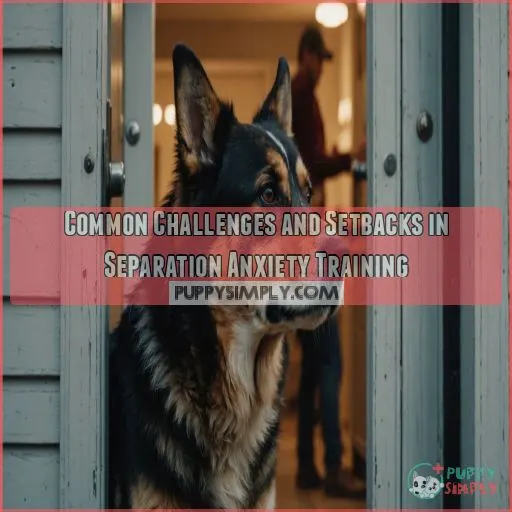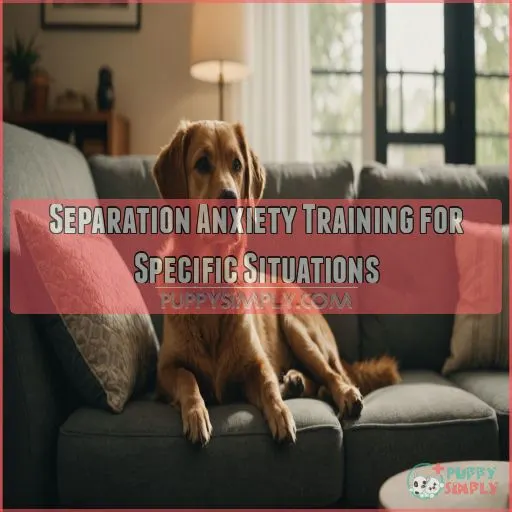This site is supported by our readers. We may earn a commission, at no cost to you, if you purchase through links.
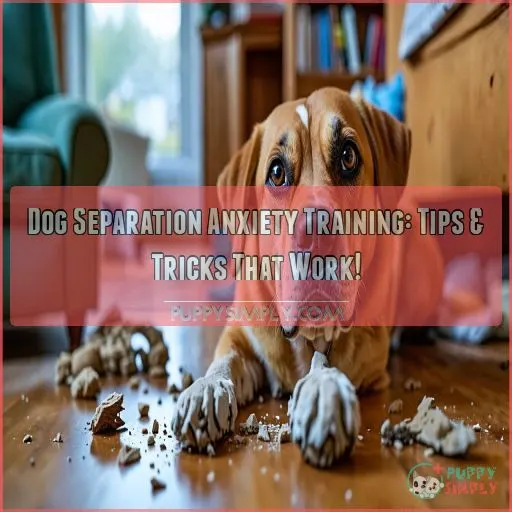
Then, start training with positive reinforcement. Reward your pup for staying calm when you leave, and gradually increase the time you’re gone.
Crate training and providing plenty of exercise can also help ease their anxiety. If it’s really severe, chat with your vet about medication or natural supplements.
With patience and the right techniques, you can help your furry friend feel more secure. Now, let’s explore some more detailed tips to tackle separation anxiety for good!
Table Of Contents
- Key Takeaways
- Recognizing Separation Anxiety
- Understanding the Causes of Separation Anxiety
- Preparing for Separation Anxiety Training
- Crate Training for Separation Anxiety
- Desensitization and Counter-Conditioning Techniques
- Exercise and Physical Activity for Separation Anxiety
- Clinginess: Playing It Cool and Encouraging Independence
- Gradual Desensitization to Separation
- Counter-Conditioning With Positive Reinforcement
- Using Treats and Toys in Separation Anxiety Training
- Managing Pre-Departure Cues and Anxiety Triggers
- Creating a Separation Anxiety Training Plan
- Managing Separation Anxiety With Medication and Supplements
- Common Challenges and Setbacks in Separation Anxiety Training
- Separation Anxiety Training for Specific Situations
- Frequently Asked Questions (FAQs)
- Can dog training help with separation anxiety?
- How can one know if they have separation anxiety?
- How do you train a separation anxiety/isolation distress dog?
- How long should a dog be trained for separation anxiety?
- Why Do Some Dogs Develop Separation Anxiety?
- How to train a dog out of separation anxiety?
- Can separation anxiety in dogs be cured?
- How to break separation anxiety between two dogs?
- How to help a dog with separation anxiety in a crate?
- How long does separation anxiety training take?
- Are certain breeds more prone to anxiety?
- Can separation anxiety be genetically inherited?
- What role does exercise play in anxiety management?
- How can routines reduce a dogs anxiety?
- Conclusion
Key Takeaways
- Start small and build up: Training for dog separation anxiety is like learning to ride a bike. Begin with short absences and gradually increase the time, using treats and toys to make the experience positive.
- Recognize the signs: Keep an eye out for behaviors like excessive barking or destructive habits. It’s like having a detective’s eye for spotting clues that indicate your dog’s stress is more than just whining for attention.
- Consistency is key: Think of training as brushing your teeth—do it regularly and stick to a routine for the best results. This helps your dog feel secure, much like your morning coffee kick-starts your day.
- Get help if needed: Sometimes, training can seem like solving a jigsaw puzzle with missing pieces. Don’t hesitate to consult a vet or a dog behaviorist for professional advice if the anxiety seems overwhelming.
Recognizing Separation Anxiety
Spotting separation anxiety in your dog can feel like you’ve stumbled upon a furry detective mystery.
If your pup turns into a four-legged drama queen every time you leave, it might be time to unravel the clues of anxiety.
Such as excessive barking or those unfortunate "oops" moments on the rug, including expressions like being a four-legged drama queen.
Signs and Symptoms of Separation Anxiety
Spotting separation anxiety in dogs can be tricky, but watch closely for these signs:
- Destructive behavior, like chewing furniture when left alone.
- Vocalization patterns, such as nonstop barking or whining.
- Noticeable body language, including trembling or pacing.
- Duration of anxiety, with signs starting soon after you leave.
Recognizing these can help ease your dog’s stress and isolation distress.
Distinguishing Between Separation Anxiety and Normal Canine Behavior
Deciphering your dog’s cues is like reading a secret code.
Is Fluffy barking or whining when you leave for fun or anxiety? If those escape attempts and destructive behavior happen only when you’re gone, you’ve likely got yourself a case of separation anxiety, not boredom.
Record their activities to spot repetitive pacing versus play.
Consider a pet sitter for support.
Common Triggers for Separation Anxiety
If your pup’s anxiety flares up when you leave, it could be triggered by major life changes like a new home, routine shifts, or even family dynamics.
Travel stress and owner absence can also set off separation anxiety. Changes in environment and routine, such as moving homes or adding a new pet, can contribute to the development of separation anxiety in dogs overcoming dog separation anxiety.
Additionally, certain breeds may be more prone to separation anxiety due to their genetic predisposition and breed-specific traits.
Stay vigilant for pre-departure cues, and use gradual desensitization and crate training to ease your dog’s worries.
Identifying a Dog’s Threshold for Separation
Recognizing a dog’s threshold for separation when triggers have been identified is like finding the sweet spot on a balancing seesaw.
Use tools like camera monitoring for insights.
Look for:
- Anxiety cues: trembling or whining.
- Threshold levels: duration before panic.
- Time tracking: note restless behavior patterns.
- Seek advice: consult a dog groomer for specific animal care suggestions.
Understanding the Causes of Separation Anxiety
To tackle your dog’s separation anxiety effectively, it’s important to know what’s causing it.
Whether it’s genetics, environment, or sudden life changes, understanding these factors can make all the difference—kind of like finding out your dog prefers peanut butter to cheese, which is a matter of understanding their preference.
Triggers of Separation Anxiety
Life changes can rattle your dog’s world, triggering separation anxiety. Factors include owner absence, routine disruption, or a past trauma. To pinpoint a dog’s separation threshold, try the stopwatch method – this involves starting a timer as the owner leaves and observing the dog’s behavior, as outlined in dog separation anxiety training.
By grasping the factors that contribute to a dog’s anxiety, like changes in routine or even the owner’s behavior, the owner will be better prepared to help their furry friend feel secure and relaxed when they’re not around. Avoid relying on a bark collar; instead, explore positive approaches like consulting a pet groomer.
| Trigger | Impact | Solution |
|---|---|---|
| Life changes | Anxiety | Gentle adjustments |
| New pet | Feeling unsafe | Introduce gradually |
| Owner absence | Stress | Short departures |
Understanding these helps you support your furry friend.
Genetics vs. Environment
With dog separation anxiety, you’ve got a classic nature vs. nurture dilemma.
Breed predisposition can hint at genetic influence, but early socialization and environmental factors play big roles, too.
It’s a bit like dogs being dealt a deck of cards—genetics and environment shape their hand.
Your ace? Shaping the environment to help manage anxiety!
Impact of Life Changes
Your dog’s world may flip upside down with life changes like moving, adding a new pet, starting a new job, or experiencing a family shake-up like divorce or growth.
Such changes can trigger separation anxiety, turning even the boldest pooch into a nervous Nellie.
Plan ahead, comforting them with stability and routine, to ease their adjustment.
Preparing for Separation Anxiety Training
Before starting separation anxiety training, make sure your dog feels safe and comfortable, whether it’s through crate training or positive associations
.
You might feel like you’re preparing for a first day of school, but with consistency and patience, you’ll see progress and your dog’s newfound independence.
Crate Training for Separation Anxiety
Crate training can be a game-changer for dogs with separation anxiety.
First, make sure the crate is the right size – not too big, not too small.
Gradually introduce your pup to the crate, and make it a cozy, positive space with treats and toys.
Stick to a routine, and stay calm when leaving.
Crate training takes time, but it’s worth it!
Desensitization and Counter-Conditioning Techniques
Imagine: you’re the maestro, orchestrating gradual exposure, cue management, and positive reinforcement to tame your dog’s anxiety triggers.
With treat training, turn those pre-departure cues into predictable operas rather than horror shows. Start small, reward big, and soon your pup will see goodbyes as temporary curtain calls, rather than full-blown dramas.
It’s like unraveling a complex plot with tasty incentives!
Exercise and Physical Activity for Separation Anxiety
Imagine taking your dog on a brisk walk or playing fetch—these exercise types can work wonders for easing separation anxiety.
Understanding anxiety triggers and keeping your pup engaged through mental stimulation, such as activities for separation anxiety in german shepherds, can build routine benefits
.
A tired dog is a happy dog and exercising before leaving can trim down anxiety.
Aim for varied exercise durations daily, as this can be a key factor in a tired dog being a happy dog.
Clinginess: Playing It Cool and Encouraging Independence
Does your clingy dog never leave your side? You can play it cool by encouraging independent play and ignoring attention-seeking antics.
It’s all about teaching calm departures and savoring alone time.
Allow your furry friend to discover self-entertainment. Remember, it’s not cold-hearted; it’s fostering confidence.
Who knew independence could be just the ticket to harmony?
Gradual Desensitization to Separation
Tackling clinginess builds a foundation for handling separation anxiety.
Gradual desensitization is your next step. Start small—grab your keys, but stay put. This minimizes anxiety and sets the stage for longer absences.
Like a comedy routine, timing is key; practice leaving for varying short periods. Stick closely to your training schedule, and remember, patience is your best friend .
Counter-Conditioning With Positive Reinforcement
After easing your dog’s anxiety with gradual desensitization, try counter-conditioning with positive reinforcement.
When your departure cues no longer cause panic, replace fear with joy using a reward system.
Treat training and clicker training are like magic wands—each click and treat turns nervousness into excited anticipation. This is an example of classical conditioning technique that comforts your dog.
This technique helps build confidence in your absence.
Using Treats and Toys in Separation Anxiety Training
Building on counter-conditioning, let’s talk treats and toys.
Think of treat-based desensitization as a superhero cape for your anxious pup. Carefully choose toy rewards and high-value treats to usher in positive reinforcement.
Experiment with creative treat delivery methods to keep Sparky guessing and engaged. Whether it’s a peanut butter-filled kong or a squeaky toy, spark joy in your dog’s alone time.
Managing Pre-Departure Cues and Anxiety Triggers
Unraveling the pre-departure puzzle is key to tackling separation anxiety. Identify your dog’s telltale cues – from jingling keys to slipping on shoes – and slowly desensitize them.
This gradual process helps your pup stay calm when you head out the door.
Try these:
- Vary the order of your departure routine
- Start with very short absences and build up slowly
- Use a camera to pinpoint your dog’s anxiety triggers
- Take regular training breaks to prevent burnout
Creating a Separation Anxiety Training Plan
Creating a solid separation anxiety training plan for your dog is like building a roadmap to calm confidence—not just theirs, but yours too.
By setting realistic goals and tracking progress, you’ll turn challenges into triumphs, making the journey a rewarding experience for both of you.
Developing a Personalized Training Plan
You’re ready to create a personalized training plan, factoring in your dog’s personality and your schedule.
Think of it like a recipe—getting the right mix is key! Keep sessions short, like 10-15 minutes, and track progress to celebrate success. Remember, patience and consistency are your best friends.
| Key Element | Consideration |
|---|---|
| Dog’s Personality | Tailor |
| Owner’s Schedule | Find the best times |
| Training Duration | Consistent routines |
| Success Tracking | Use gradual steps |
Setting Realistic Goals and Expectations
Tackling separation anxiety with your dog requires a sprinkle of patience and a spoonful of humor.
Set modest, attainable goals to see real progress.
Use a realistic timeline:
- Aim for two-minute absences without panic.
- Stick with consistent training—just like brushing your teeth.
- Celebrate small wins—each is a step in the direction of overcoming setbacks.
Tracking Progress and Adjusting the Training Plan
Imagine being a detective—monitoring progress is your magnifying glass!
Adjust the training duration as needed, setting milestones that guide your dog toward success.
Evaluate methods like you’re taste-testing grandma’s pie recipe, tweaking ingredients as you go.
Don’t shy away from seeking feedback; it’s like getting directions when you’re lost, ensuring your plan stays on track .
Seeking Professional Help and Guidance
As you fine-tune the training plan, consider seeking professional guidance.
A certified trainer can provide personalized advice and solutions, such as:
- Behaviorist recommendations: Their expert insights make a world of difference.
- Treatment options: Explore systematic desensitization and medication management.
- Cost comparison: Balance professional help with your budget.
Remember, a helping hand speeds up success!
Managing Separation Anxiety With Medication and Supplements
If your pup’s separation anxiety is really giving you the blues, don’t worry – there are meds and supplements that can help.
Prescription anxiety medications and natural calming aids like CBD can take the edge off, so you and your furry friend can get through the tough times with a little more ease.
Prescription Medications for Separation Anxiety
You might sometimes feel managing Fido’s separation anxiety is like herding cats, but medication can help.
Veterinarians often recommend meds like fluoxetine, balancing side effects and effectiveness with careful dosage.
Always consult your vet for personalized advice.
Remember, medication isn’t a quick fix; it’s part of a broader strategy to ease your dog’s anxiety .
Natural Supplements and Alternative Therapies
Look to natural supplements and alternative therapies; they might just be the bee’s knees for calming your anxious pup.
Consider using:
- CBD oil for its soothing properties.
- Herbal remedies like chamomile.
- Calming pheromones to create a serene environment.
- Acupuncture and homeopathy as holistic approaches.
These can be a gentle way to manage separation anxiety without any fuss, like calming aids for severe cases
.
Combining Medication and Training for Optimal Results
After exploring natural supplements, consider blending medication and training to tackle separation anxiety.
Think of medication as the helping hand paired with a sturdy ladder, aiding your dog in climbing down anxious peaks.
Focus on medication timing and dosage adjustments, monitoring training progress like a hawk.
Remember, adjustments are key ensuring medication withdrawal is as smooth as a walk in the park.
Potential Side Effects and Risks of Medication
Figuring out medication for dog anxiety feels like walking a tightrope. You balance benefits with risks—common side effects like lethargy or vomiting can appear. Always consult your vet about drug interactions and long effects.
Monitoring changes in your pup’s behavior keeps you informed, where you can also consider exploring dog anxiety medication alternatives, such as natural calming methods, to ease anxiety symptoms.
Additionally, recognizing the physical symptoms of dog anxiety, like excessive panting and shaking, is key for early detection. A bit like a detective sniffing clues, right? Stay vigilant, your dog’s well-being depends on it.
Common Challenges and Setbacks in Separation Anxiety Training
When you’re knee-deep in separation anxiety training, roadblocks like trigger stacking or a stubborn plateau might make you feel like you’re stuck in traffic without snacks.
Don’t worry, we’ve got some practical tips to help you navigate these bumps and keep your training on track.
Trigger Stacking and Managing Stress
How do you manage stress when separation anxiety triggers, like those experienced by English Bulldogs with separation anxiety, stack up like a Jenga tower ready to topple English Bulldogs with separation anxiety
?
Understand your dog’s stressors and give them time to reset. Use coping mechanisms and relaxation techniques to keep them calm.
A consistent daily routine can be a lifesaver. Remember, your calm demeanor also helps manage their stress.
Avoiding Overwhelming the Dog and Preventing Burnout
With your pup’s separation anxiety training, it’s essential to avoid overwhelming them and prevent burnout.
Take regular breaks, celebrate small wins, and adjust the pace as needed.
Use positive reinforcement, not punishment, and manage stress levels – for both you and your dog.
Slow progress is still progress, so stay patient and keep your training sessions upbeat.
Managing Separation Anxiety in Multi-Dog Households
Even in multi-dog households, you can manage separation anxiety by considering pack dynamics. Picture yourself the conductor of a canine symphony, ensuring harmony among varied personalities.
Address challenges by:
- Recognizing the pack hierarchy and competing needs.
- Tailoring training strategies for individual responses.
- Maintaining consistency in rules and routines.
Balanced leadership makes a world of difference!
Overcoming Plateaus and Stagnation in Training
Managing multiple dogs can be tricky, but hitting a training plateau feels like watching paint dry.
Consistency matters! Keep using positive reinforcement and shake things up to avoid stagnation.
If progress stalls, don’t hesitate to seek professional help. Remember, every dog has its own pace, and setbacks are part of the journey.
Stay patient and persistent!
Separation Anxiety Training for Specific Situations
Got a pup who’s stressed out in your cozy apartment, or maybe a senior dog with health issues?
Tackling separation anxiety in these specific situations can feel like solving a riddle.
But with a little patience and some clever tricks, you can help your furry friend feel more at ease, using a little patience.
Training for Separation Anxiety in Apartments and Small Spaces
Training your pup for separation anxiety in an apartment can feel like squeezing a watermelon into a handbag, but it’s doable!
Embrace these tips:
- Create a cozy crate retreat.
- Desensitize with brief balcony sightings.
- Use high-value treats for crate training adaptations.
- Rotate toys to combat small space challenges.
- Install a dog cam for extra peace of mind.
Managing Separation Anxiety in Dogs With Medical Conditions
When your pup’s medical condition complicates separation anxiety, it’s important to have a vet partnership. They’ll guide you on medication considerations.
Making condition-specific training a breeze requires thinking of lifestyle adjustments like stress management techniques designed for your dog’s needs, utilizing tools like calming aids for Rottweilers separation anxiety solutions
.
After all, it’s not just about patience—it’s about having a whole game plan, treating every challenge as an opportunity.
Separation Anxiety Training for Dogs With Noise Phobias
Imagine your dog feels spooked by loud noises.
- Identify noise phobia triggers and use sound therapy to soothe nerves.
- Create safe spaces with cozy vibes and calming aids.
- Gradually apply desensitization strategies—baby steps work wonders!
- Be patient and consistent, balancing empathy and training.
Your furry friend’s peace of mind is achievable!
Frequently Asked Questions (FAQs)
Can dog training help with separation anxiety?
Desensitization definitely helps with a dog’s separation stress.
Gradually increase alone time, staying below their anxiety threshold to avoid setbacks.
Use video tools for training and observe their behavior, tweaking your approach as needed to improve their behavior.
How can one know if they have separation anxiety?
You’re feeling overly worried when apart from loved ones.
Maybe even losing sleep over it.
Symptoms like headaches, nausea, or nightmares might pop up too.
Sound familiar? Chat with a pro to ease those worries (Source).
How do you train a separation anxiety/isolation distress dog?
Think of training your dog like planting the seed of calm.
Use special treats when leaving, and remove cues like grabbing keys to reduce stress.
Patience wins.
How long should a dog be trained for separation anxiety?
Training your dog for separation anxiety typically takes weeks to months, depending on severity and consistency.
Start with short absences and gradually increase time.
Remember, patience is key—each dog is unique, so progress may vary.
Why Do Some Dogs Develop Separation Anxiety?
Dogs might develop separation anxiety due to factors like early separation from their litter, changes in routine, or lack of exposure to varied environments.
It’s like them feeling lost in a big, spooky maze.
How to train a dog out of separation anxiety?
Feeling anxious when your pup’s alone?
Don’t worry, we’ve got your back!
Slowly build their confidence with gradual departures, positive reinforcement, and a cozy space.
Soon, they’ll be wagging their tail, not chewing the furniture, with positive reinforcement.
Can separation anxiety in dogs be cured?
You can manage separation anxiety with consistent training, but completely curing it may take more time, patience, and even medication in severe cases.
Every dog is different, and progress isn’t always linear.
How to break separation anxiety between two dogs?
Breaking separation anxiety between two dogs is no walk in the park.
Gradually increase their time apart using desensitization. Reward calm behavior and make goodbyes no drama.
Over time, they’ll learn independence and feel secure.
How to help a dog with separation anxiety in a crate?
Make the crate a cozy haven for your dog by adding a comfy bed and using positive reinforcement.
Start small by just aiming for short periods of calm time.
Patience and consistency are your best allies (Source).
How long does separation anxiety training take?
Training for separation anxiety can take weeks to a year, depending on your dog’s progress.
Consistent, gradual desensitization sessions help.
Watch for signs of stress, and don’t push your dog beyond their comfort zone.
Are certain breeds more prone to anxiety?
You might think every dog breeds alike, but some are more prone to anxiety.
Breeds like Labradors, Border Collies, and Australian Shepherds often need extra attention to feel secure when you’re away.
Can separation anxiety be genetically inherited?
Separation anxiety in dogs might have a genetic component, suggesting some pups are born with a predisposition.
However, environmental factors like early experiences and changes in routine also play significant roles in developing this condition.
What role does exercise play in anxiety management?
Help your dog find their inner calm through the power of exercise! Regular physical activity boosts their mood and also helps manage anxiety, providing a natural and side-effect-free solution.
How can routines reduce a dogs anxiety?
A dog thrives on predictability, making a routine one of the best anxiety busters.
Knowing when to expect walks or meals gives them security.
It’s like a comforting lullaby that helps ease their fretful thoughts (Source).
Conclusion
Did you know that nearly 40% of dogs experience some form of separation anxiety? Tackling it isn’t just about making your life easier—you’re also helping your furry friend feel safe and content.
Remember, dog separation anxiety training involves a mix of techniques like crate training, positive reinforcement, and maybe even medicating if necessary.
Stick with it, and you’ll see progress. Soon, both you and your dog will feel more at ease, no matter how long you’re apart, and that’s a great way to make your life easier.

